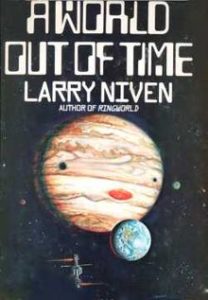 A 1976 classic hard sci-fi, Niven’s A World Out of Time is a fun adventure. It was originally two short stories, and that ancestry shows. In the first part, a criminal is reprogrammed to be loyal to the state, then, since he is expendable, he is sent out on a suicide mission in a starship to seed likely planets with terraforming elements. But he has a rebellious turn and decides to run away with the starship instead. He heads straight for the galactic core. Why? No reason, he just does. He goes cryogenic for most of that journey.
A 1976 classic hard sci-fi, Niven’s A World Out of Time is a fun adventure. It was originally two short stories, and that ancestry shows. In the first part, a criminal is reprogrammed to be loyal to the state, then, since he is expendable, he is sent out on a suicide mission in a starship to seed likely planets with terraforming elements. But he has a rebellious turn and decides to run away with the starship instead. He heads straight for the galactic core. Why? No reason, he just does. He goes cryogenic for most of that journey.
The ship’s computer finally talks him into returning to earth, but he’s already so old, he’ll never survive the return unless the ship slingshots around a black hole’s accretion disk and thanks to relativistic time dilation and some vigorous hand-waving, he will live long enough to make the trip home.
Upon arriving again on Earth, he is three million years in the future, earth time, and the entire solar system has been re-engineered, with the planets in different orbits. He lands on Earth anyway and begins the second part of the tale, survival, exploration and discovery on Earth.
In this second story, climate change and wars have wiped out nearly all life, but the protagonist is an old man, so what does he care? At least he’s home. But wait, there is a rumor of immortality and he meets some pre-pubescent boys who are immortal. The search is on for the fountain of youth. An antagonist appears, improbably, another starship captain who went through a very similar experience and also wants the elixir of life. They battle it out.
The first part of the story was quite engaging, with its descriptions of huge changes in scale – scales of intergalactic time and space that boggle the mind. That exercise reminded me of The Three Body Problem, a recent hard SF novel. The second story plodded, with dramatic tension driven not by character motivation but by a never-ending parade of high-speed gizmos, elevators, subways, flying cars, and special weapons. All of that became tedious quickly. Gizmos are just gizmos.
The first story was psi-fi, concerning a man’s confrontation with aging and mortality, and the possibility of beating the inexorability of time with some time-space warping. It also developed a good relationship between the protagonist and the ship’s AI computer, a relationship that reminded me of a parallel one between the astronaut and an alien in The Spaceman of Bohemia.
The second story is more Star-Warsy, lots of formulaic chases and battles driven by an unlikely MacGuffin. A few interesting themes surfaced, such as what would a world be like that was ruled by children? What would sexuality be like in a world of immortals? But these questions, while interesting, did not intersect with scientific technology in a way that qualified them as psi-fi.
So I recommend the novel for that first part of the story. The second part is okay and can be skimmed.
Niven, Larry (1976). A World Out of Time. New York: Holt, Rinehart & Winston (214 pp).